| Triphoturus | |
|---|---|
| Scientific classification | |
| Domain: | Eukaryota |
| Kingdom: | Animalia |
| Phylum: | Chordata |
| Class: | Actinopterygii |
| Order: | Myctophiformes |
| Family: | Myctophidae |
| Genus: | Triphoturus Fraser-Brunner, 1949 |
Triphoturus is a genus of lanternfishes.
| Triphoturus | |
|---|---|
| Scientific classification | |
| Domain: | Eukaryota |
| Kingdom: | Animalia |
| Phylum: | Chordata |
| Class: | Actinopterygii |
| Order: | Myctophiformes |
| Family: | Myctophidae |
| Genus: | Triphoturus Fraser-Brunner, 1949 |
Triphoturus is a genus of lanternfishes.
There are currently three recognized species in this genus: [1]
Genus is a taxonomic rank used in the biological classification of living and fossil organisms as well as viruses. In the hierarchy of biological classification, genus comes above species and below family. In binomial nomenclature, the genus name forms the first part of the binomial species name for each species within the genus.

In taxonomy, binomial nomenclature, also called binominal nomenclature or binary nomenclature, is a formal system of naming species of living things by giving each a name composed of two parts, both of which use Latin grammatical forms, although they can be based on words from other languages. Such a name is called a binomial name, a binomen, binominal name, or a scientific name; more informally it is also historically called a Latin name.

Columbidae is a bird family consisting of doves and pigeons. It is the only family in the order Columbiformes. These are stout-bodied birds with short necks and short slender bills that in some species feature fleshy ceres. They primarily feed on seeds, fruits, and plants. The family occurs worldwide, but the greatest variety is in the Indomalayan and Australasian realms.

Starlings are small to medium-sized passerine birds in the family Sturnidae. The Sturnidae are named for the genus Sturnus, which in turn comes from the Latin word for starling, sturnus. Many Asian species, particularly the larger ones, are called mynas, and many African species are known as glossy starlings because of their iridescent plumage. Starlings are native to Europe, Asia, and Africa, as well as northern Australia and the islands of the tropical Pacific. Several European and Asian species have been introduced to these areas, as well as North America, Hawaii, and New Zealand, where they generally compete for habitats with native birds and are considered to be invasive species. The starling species familiar to most people in Europe and North America is the common starling, and throughout much of Asia and the Pacific, the common myna is indeed common.
In biology, a monotypic taxon is a taxonomic group (taxon) that contains only one immediately subordinate taxon. A monotypic species is one that does not include subspecies or smaller, infraspecific taxa. In the case of genera, the term "unispecific" or "monospecific" is sometimes preferred. In botanical nomenclature, a monotypic genus is a genus in the special case where a genus and a single species are simultaneously described. In contrast, an oligotypic taxon contains more than one but only a very few subordinate taxa.

In zoological nomenclature, a type species is the species name with which the name of a genus or subgenus is considered to be permanently taxonomically associated, i.e., the species that contains the biological type specimen. A similar concept is used for suprageneric groups and called a type genus.
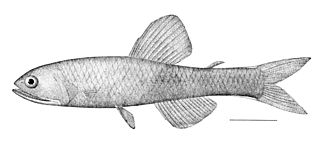
Lampanyctus is a genus of lanternfishes.

Ceratoscopelus is a genus of lanternfish.
Parvilux is a genus of lanternfishes.

In biology, taxonomic rank is the relative level of a group of organisms in an ancestral or hereditary hierarchy. A common system of biological classification (taxonomy) consists of species, genus, family, order, class, phylum, kingdom, and domain. While older approaches to taxonomic classification were phenomenological, forming groups on the basis of similarities in appearance, organic structure and behaviour, methods based on genetic analysis have opened the road to cladistics.
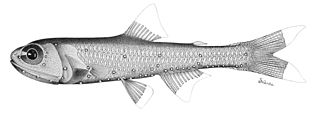
Bolinichthys is a genus of lanternfishes.
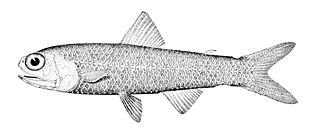
Lampadena is a genus of lanternfishes.
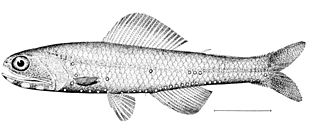
Notoscopelus is a genus of lanternfishes.
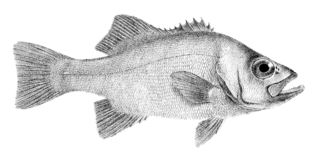
Dinoperca is a genus in the family Dinopercidae (cavebasses). It contains the single species Dinoperca petersi, the lampfish, which is native to reefs of the western Indian Ocean, where it can be found down to depths of 50 m (160 ft). It prefers to inhabit the spaces under ledges, as well as the mouths of caves. This species grows to 75 cm (30 in) in total length. It is of minor importance to local commercial fisheries, but is popular as a sport fish. The identity of the person honoured in the specific name is not stated but Day thanks "Professor Peters" for his assistance in identifying the type who was Director of the Berlin Museum, this refers to Wilhelm Peters (1815-1883).
The northern lampfish, also known as smallfin lanternfish, is a small oceanic fish in the family Myctophidae. First described by husband and wife ichthyologists Carl H. and Rosa Smith Eigenmann in 1890, it is named for the numerous small round photophores that line the ventral surface of its head and body.
Lampfish is a common name for several fishes and may refer to:
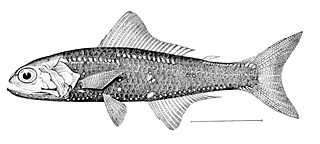
Notoscopelus resplendens, commonly known as the patchwork lampfish or patchwork lanternfish, is a species of lanternfish in the family Myctophidae. It is found in the eastern and western Atlantic Ocean, the Indian Ocean and parts of the Pacific Ocean. It spends the daylight hours in deep water, rising at night to near the surface. This fish was first described by the Scottish naturalist and arctic explorer John Richardson in 1845.
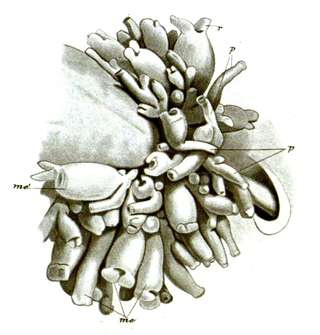
Hydrichthys sarcotretis is a species of colonial marine hydrozoans now included in the family Pandeidae. The polyps of members of this genus are parasitic and attach themselves to a fish. H. sarcotretis is a species that exhibits hyperparasitism by attaching itself to a copepod, itself the parasite of a fish.
Lampanyctus nobilis, the noble lampfish, is a species of lanternfish.